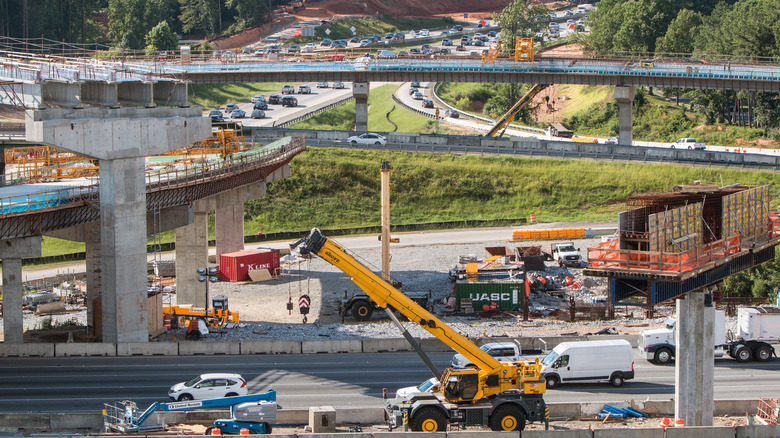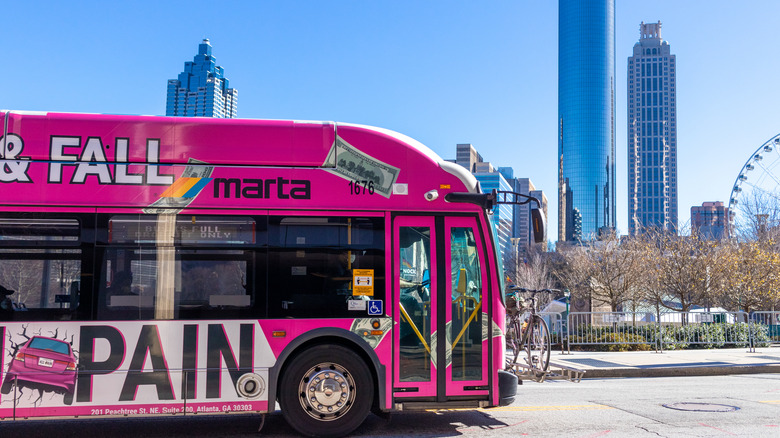If You're Traveling Through The Southeast, Make Sure To Avoid This Deadly Road
Sometimes, all you want is a little road trip to Atlanta, Georgia. Just a carefree visit to the Georgia Aquarium, the World of Coca-Cola, or maybe the College Football Hall of Fame. You've heard great things about this sprawling state capital, and you've got a hankering for peach cobbler. You even know the places in Atlanta where you're most likely to spot celebrities.
Then it happens: You're stuck on a 12-lane superhighway, hemmed in by big rigs, RVs, and mammoth pickups. There's gridlock as far as you can see. Sirens blare as rescue vehicles try to punch through. Your AC does battle against Georgia's subtropical heat and humidity. You can't see the fender-bender ahead, but you'll soon learn that it's just one of thousands of accidents that take place on "the Perimeter" each year. The road you are driving is I-285, an interstate highway that makes a 64-mile circuit around the city of Atlanta. By some estimates, each year brings about 3.5 auto-related fatalities per 10 miles of road, making I-285 one of the deadliest roads in the United States.
Atlanta's perfect storm for dangerous traffic
The reasons for all this traffic are pretty benign. Atlanta is a thriving city, and lots of folks want to live there. More than 68,000 people moved to the metropolitan area in 2023, making Atlanta the third-fastest-growing region in the United States. That level of growth requires a lot of construction — of housing, services, and infrastructure — to keep up with demand. When the I-285 loop was completed in 1969, it was supposed to help matters; the "Perimeter" would expedite travel around Atlanta's vast suburbs, and drivers could drift off at the appropriate exit. Atlanta is hardly alone; this circular design philosophy was also applied to the Capital Beltway in Washington, D.C., and I-695 around Baltimore, among countless other cities and states.
So what makes I-285 so treacherous? Theories abound, but most collisions occur around highway junctions. For example, the meeting point between I-285 and I-400 is an infamous bottleneck, and that was before an $800 million improvement project flooded the area with construction vehicles. Another trouble spot is the intersection between I-285 and I-85, a tangle of overpasses known locally as "Spaghetti Junction." Interestingly, large trucks are rarely allowed inside the Perimeter. This eases inner-city traffic but means that I-285 is a busy corridor for semitrailers. These environmental factors add a lot of stress to a daily commute, and surveys suggest that as many as 80% of Georgia drivers have experienced road rage. Before you even think of driving around Atlanta, review the most dangerous mistakes you can make while driving on your next road trip.
How to avoid the Perimeter (and have more fun)
Then again, visitors to A-Town don't have to drive if they don't want to. Atlanta is a very automotive city, but it also has MARTA, a comprehensive mass transit system with buses, trains, and even street cars. You can buy a "Breeze Card" or download MARTA's Breeze app, making it easy to pay your fare. Half a million people ride the MARTA network every weekday, and not one of those people ever has to maneuver around a backhoe and orange cones to reach a traffic-choked onramp. Hartfield-Jackson Atlanta International Airport is a major East Coast hub, and you can hop a train at the airport for $3 and coast downtown in just 25 minutes. Once there, you can use the Relay Bike Share app to rent a bicycle and pedal it around town.
If you do need (or want) to drive through Atlanta, one option is to filter highway routes out of your GPS directions. That way, you'll only take surface roads, which may take longer but will avoid the Perimeter altogether. You'll also see more of the actual city instead of distant suburbs beyond concrete barriers. Driving in downtown Atlanta also means you'll be minutes from this underrated state park with mesmerizing trails.


